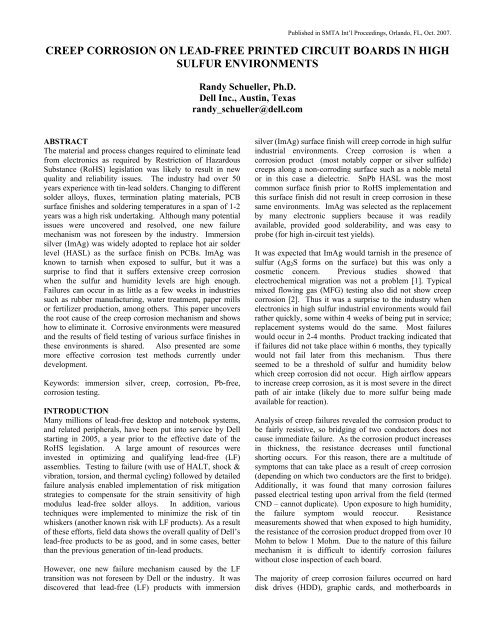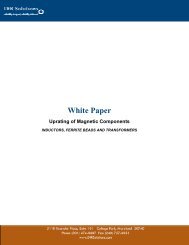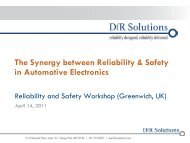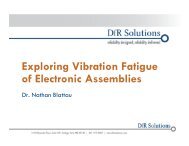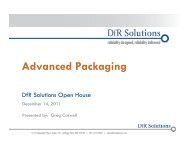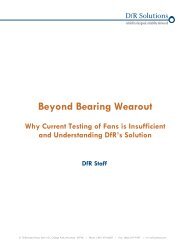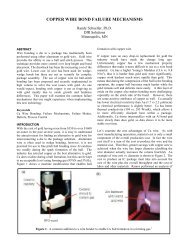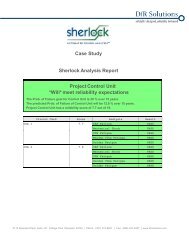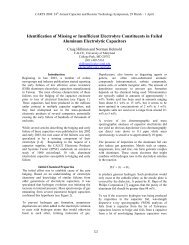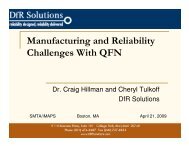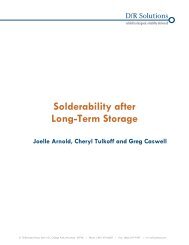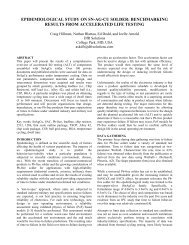creep corrosion on lead-free printed circuit boards in ... - DfR Solutions
creep corrosion on lead-free printed circuit boards in ... - DfR Solutions
creep corrosion on lead-free printed circuit boards in ... - DfR Solutions
- No tags were found...
Create successful ePaper yourself
Turn your PDF publications into a flip-book with our unique Google optimized e-Paper software.
Published <strong>in</strong> SMTA Int’l Proceed<strong>in</strong>gs, Orlando, FL, Oct. 2007.CREEP CORROSION ON LEAD-FREE PRINTED CIRCUIT BOARDS IN HIGHSULFUR ENVIRONMENTSRandy Schueller, Ph.D.Dell Inc., Aust<strong>in</strong>, Texasrandy_schueller@dell.comABSTRACTThe material and process changes required to elim<strong>in</strong>ate <strong>lead</strong>from electr<strong>on</strong>ics as required by Restricti<strong>on</strong> of HazardousSubstance (RoHS) legislati<strong>on</strong> was likely to result <strong>in</strong> newquality and reliability issues. The <strong>in</strong>dustry had over 50years experience with t<strong>in</strong>-<strong>lead</strong> solders. Chang<strong>in</strong>g to differentsolder alloys, fluxes, term<strong>in</strong>ati<strong>on</strong> plat<strong>in</strong>g materials, PCBsurface f<strong>in</strong>ishes and solder<strong>in</strong>g temperatures <strong>in</strong> a span of 1-2years was a high risk undertak<strong>in</strong>g. Although many potentialissues were uncovered and resolved, <strong>on</strong>e new failuremechanism was not foreseen by the <strong>in</strong>dustry. Immersi<strong>on</strong>silver (ImAg) was widely adopted to replace hot air solderlevel (HASL) as the surface f<strong>in</strong>ish <strong>on</strong> PCBs. ImAg wasknown to tarnish when exposed to sulfur, but it was asurprise to f<strong>in</strong>d that it suffers extensive <str<strong>on</strong>g>creep</str<strong>on</strong>g> <str<strong>on</strong>g>corrosi<strong>on</strong></str<strong>on</strong>g>when the sulfur and humidity levels are high enough.Failures can occur <strong>in</strong> as little as a few weeks <strong>in</strong> <strong>in</strong>dustriessuch as rubber manufactur<strong>in</strong>g, water treatment, paper millsor fertilizer producti<strong>on</strong>, am<strong>on</strong>g others. This paper uncoversthe root cause of the <str<strong>on</strong>g>creep</str<strong>on</strong>g> <str<strong>on</strong>g>corrosi<strong>on</strong></str<strong>on</strong>g> mechanism and showshow to elim<strong>in</strong>ate it. Corrosive envir<strong>on</strong>ments were measuredand the results of field test<strong>in</strong>g of various surface f<strong>in</strong>ishes <strong>in</strong>these envir<strong>on</strong>ments is shared. Also presented are somemore effective <str<strong>on</strong>g>corrosi<strong>on</strong></str<strong>on</strong>g> test methods currently underdevelopment.Keywords: immersi<strong>on</strong> silver, <str<strong>on</strong>g>creep</str<strong>on</strong>g>, <str<strong>on</strong>g>corrosi<strong>on</strong></str<strong>on</strong>g>, Pb-<strong>free</strong>,<str<strong>on</strong>g>corrosi<strong>on</strong></str<strong>on</strong>g> test<strong>in</strong>g.INTRODUCTIONMany milli<strong>on</strong>s of <strong>lead</strong>-<strong>free</strong> desktop and notebook systems,and related peripherals, have been put <strong>in</strong>to service by Dellstart<strong>in</strong>g <strong>in</strong> 2005, a year prior to the effective date of theRoHS legislati<strong>on</strong>. A large amount of resources were<strong>in</strong>vested <strong>in</strong> optimiz<strong>in</strong>g and qualify<strong>in</strong>g <strong>lead</strong>-<strong>free</strong> (LF)assemblies. Test<strong>in</strong>g to failure (with use of HALT, shock &vibrati<strong>on</strong>, torsi<strong>on</strong>, and thermal cycl<strong>in</strong>g) followed by detailedfailure analysis enabled implementati<strong>on</strong> of risk mitigati<strong>on</strong>strategies to compensate for the stra<strong>in</strong> sensitivity of highmodulus <strong>lead</strong>-<strong>free</strong> solder alloys. In additi<strong>on</strong>, varioustechniques were implemented to m<strong>in</strong>imize the risk of t<strong>in</strong>whiskers (another known risk with LF products). As a resultof these efforts, field data shows the overall quality of Dell’s<strong>lead</strong>-<strong>free</strong> products to be as good, and <strong>in</strong> some cases, betterthan the previous generati<strong>on</strong> of t<strong>in</strong>-<strong>lead</strong> products.However, <strong>on</strong>e new failure mechanism caused by the LFtransiti<strong>on</strong> was not foreseen by Dell or the <strong>in</strong>dustry. It wasdiscovered that <strong>lead</strong>-<strong>free</strong> (LF) products with immersi<strong>on</strong>silver (ImAg) surface f<strong>in</strong>ish will <str<strong>on</strong>g>creep</str<strong>on</strong>g> corrode <strong>in</strong> high sulfur<strong>in</strong>dustrial envir<strong>on</strong>ments. Creep <str<strong>on</strong>g>corrosi<strong>on</strong></str<strong>on</strong>g> is when a<str<strong>on</strong>g>corrosi<strong>on</strong></str<strong>on</strong>g> product (most notably copper or silver sulfide)<str<strong>on</strong>g>creep</str<strong>on</strong>g>s al<strong>on</strong>g a n<strong>on</strong>-corrod<strong>in</strong>g surface such as a noble metalor <strong>in</strong> this case a dielectric. SnPb HASL was the mostcomm<strong>on</strong> surface f<strong>in</strong>ish prior to RoHS implementati<strong>on</strong> andthis surface f<strong>in</strong>ish did not result <strong>in</strong> <str<strong>on</strong>g>creep</str<strong>on</strong>g> <str<strong>on</strong>g>corrosi<strong>on</strong></str<strong>on</strong>g> <strong>in</strong> thesesame envir<strong>on</strong>ments. ImAg was selected as the replacementby many electr<strong>on</strong>ic suppliers because it was readilyavailable, provided good solderability, and was easy toprobe (for high <strong>in</strong>-<strong>circuit</strong> test yields).It was expected that ImAg would tarnish <strong>in</strong> the presence ofsulfur (Ag 2 S forms <strong>on</strong> the surface) but this was <strong>on</strong>ly acosmetic c<strong>on</strong>cern. Previous studies showed thatelectrochemical migrati<strong>on</strong> was not a problem [1]. Typicalmixed flow<strong>in</strong>g gas (MFG) test<strong>in</strong>g also did not show <str<strong>on</strong>g>creep</str<strong>on</strong>g><str<strong>on</strong>g>corrosi<strong>on</strong></str<strong>on</strong>g> [2]. Thus it was a surprise to the <strong>in</strong>dustry whenelectr<strong>on</strong>ics <strong>in</strong> high sulfur <strong>in</strong>dustrial envir<strong>on</strong>ments would failrather quickly, some with<strong>in</strong> 4 weeks of be<strong>in</strong>g put <strong>in</strong> service;replacement systems would do the same. Most failureswould occur <strong>in</strong> 2-4 m<strong>on</strong>ths. Product track<strong>in</strong>g <strong>in</strong>dicated thatif failures did not take place with<strong>in</strong> 6 m<strong>on</strong>ths, they typicallywould not fail later from this mechanism. Thus thereseemed to be a threshold of sulfur and humidity belowwhich <str<strong>on</strong>g>creep</str<strong>on</strong>g> <str<strong>on</strong>g>corrosi<strong>on</strong></str<strong>on</strong>g> did not occur. High airflow appearsto <strong>in</strong>crease <str<strong>on</strong>g>creep</str<strong>on</strong>g> <str<strong>on</strong>g>corrosi<strong>on</strong></str<strong>on</strong>g>, as it is most severe <strong>in</strong> the directpath of air <strong>in</strong>take (likely due to more sulfur be<strong>in</strong>g madeavailable for reacti<strong>on</strong>).Analysis of <str<strong>on</strong>g>creep</str<strong>on</strong>g> failures revealed the <str<strong>on</strong>g>corrosi<strong>on</strong></str<strong>on</strong>g> product tobe fairly resistive, so bridg<strong>in</strong>g of two c<strong>on</strong>ductors does notcause immediate failure. As the <str<strong>on</strong>g>corrosi<strong>on</strong></str<strong>on</strong>g> product <strong>in</strong>creases<strong>in</strong> thickness, the resistance decreases until functi<strong>on</strong>alshort<strong>in</strong>g occurs. For this reas<strong>on</strong>, there are a multitude ofsymptoms that can take place as a result of <str<strong>on</strong>g>creep</str<strong>on</strong>g> <str<strong>on</strong>g>corrosi<strong>on</strong></str<strong>on</strong>g>(depend<strong>in</strong>g <strong>on</strong> which two c<strong>on</strong>ductors are the first to bridge).Additi<strong>on</strong>ally, it was found that many <str<strong>on</strong>g>corrosi<strong>on</strong></str<strong>on</strong>g> failurespassed electrical test<strong>in</strong>g up<strong>on</strong> arrival from the field (termedCND – cannot duplicate). Up<strong>on</strong> exposure to high humidity,the failure symptom would reoccur. Resistancemeasurements showed that when exposed to high humidity,the resistance of the <str<strong>on</strong>g>corrosi<strong>on</strong></str<strong>on</strong>g> product dropped from over 10Mohm to below 1 Mohm. Due to the nature of this failuremechanism it is difficult to identify <str<strong>on</strong>g>corrosi<strong>on</strong></str<strong>on</strong>g> failureswithout close <strong>in</strong>specti<strong>on</strong> of each board.The majority of <str<strong>on</strong>g>creep</str<strong>on</strong>g> <str<strong>on</strong>g>corrosi<strong>on</strong></str<strong>on</strong>g> failures occurred <strong>on</strong> harddisk drives (HDD), graphic cards, and mother<strong>boards</strong> <strong>in</strong>
Published <strong>in</strong> SMTA Int’l Proceed<strong>in</strong>gs, Orlando, FL, Oct. 2007.desktop or workstati<strong>on</strong> systems (<strong>on</strong>ly those with ImAg PCBf<strong>in</strong>ish were affected). HDDs with high-temperature organicsolder preservative (HT OSP) surface f<strong>in</strong>ish <strong>in</strong> the samesulfur envir<strong>on</strong>ments did not show signs of <str<strong>on</strong>g>corrosi<strong>on</strong></str<strong>on</strong>g>.Failures <strong>in</strong> notebooks systems have not been found,presumably because cool<strong>in</strong>g takes place by airflow across aheat pipe. There is no airflow directly across the <strong>boards</strong>urface, as is the case for DT or WS systems. Creep<str<strong>on</strong>g>corrosi<strong>on</strong></str<strong>on</strong>g> was found <strong>on</strong> PCBs supplied by 5 differentvendors and <strong>in</strong>cluded the two major ImAg chemistries.Thus it was quickly determ<strong>in</strong>ed that this was not a supplierc<strong>on</strong>tam<strong>in</strong>ati<strong>on</strong> issue.The first evidence of the vulnerability of ImAg surfacef<strong>in</strong>ish <strong>in</strong> <strong>in</strong>dustrial envir<strong>on</strong>ments was documented by Vealefrom Rockwell [3]. His study compared ImAg, OSP, ImSn,and ENIG under bias and mixed flow<strong>in</strong>g gas. He c<strong>on</strong>cludedthat OSP and ImSn could survive an ISA G2 envir<strong>on</strong>mentbut that ImAg and ENIG could not. ImAg failed bydendritic growth of Ag and growth of Cu 2 S. A recent paperby Mazurkiewicz of HP documented several case studieswhere <str<strong>on</strong>g>creep</str<strong>on</strong>g> <str<strong>on</strong>g>corrosi<strong>on</strong></str<strong>on</strong>g> of ImAg f<strong>in</strong>ish caused failures ofcomputer systems <strong>in</strong> high sulfur envir<strong>on</strong>ments [4]. It wasstated <strong>in</strong> this paper that sulfur based <str<strong>on</strong>g>corrosi<strong>on</strong></str<strong>on</strong>g> failures<strong>in</strong>creased dramatically up<strong>on</strong> <strong>in</strong>troducti<strong>on</strong> of ImAg surfacef<strong>in</strong>ish <strong>on</strong> computer products (due to ROHS requirements).Alcatel-Lucent also has experience with this issue and Xuet.al. published a paper detail<strong>in</strong>g their work with mixedflow<strong>in</strong>g gas test<strong>in</strong>g of various LF surface f<strong>in</strong>ishes and theirresistance to <str<strong>on</strong>g>creep</str<strong>on</strong>g> <str<strong>on</strong>g>corrosi<strong>on</strong></str<strong>on</strong>g> [6].Approximately 8.8 milli<strong>on</strong> t<strong>on</strong>s of sulfur is produced eachyear <strong>in</strong> the US al<strong>on</strong>e [5]. The primary <strong>in</strong>dustries known tobe high <strong>in</strong> sulfur <strong>in</strong>clude: rubber manufactur<strong>in</strong>g (fromvulcanizati<strong>on</strong>), water treatment, fertilizer, paper mills,m<strong>in</strong><strong>in</strong>g (smelt<strong>in</strong>g), petrochemical, clay model<strong>in</strong>g andmanufacture of sulfuric acid (to name a few). Additi<strong>on</strong>ally,there are locati<strong>on</strong>s <strong>in</strong> India where office parks have beenbuilt <strong>on</strong> or near former land fills that emit H 2 S and havebeen documented to cause <str<strong>on</strong>g>corrosi<strong>on</strong></str<strong>on</strong>g> [14]. The failure ratefrom <str<strong>on</strong>g>creep</str<strong>on</strong>g> <str<strong>on</strong>g>corrosi<strong>on</strong></str<strong>on</strong>g> is very small when c<strong>on</strong>sider<strong>in</strong>g all LFproducts <strong>in</strong> the market, however it is critical that this newfailure mechanism is resolved s<strong>in</strong>ce these important<strong>in</strong>dustries obviously cannot functi<strong>on</strong> without the use ofelectr<strong>on</strong>ics.FAILURE ANALYSIS AND OBSERVATIONSA typical <str<strong>on</strong>g>creep</str<strong>on</strong>g> <str<strong>on</strong>g>corrosi<strong>on</strong></str<strong>on</strong>g> failure is shown <strong>in</strong> Figure 1.Figure 2 provides an EDX spectrum of the <str<strong>on</strong>g>corrosi<strong>on</strong></str<strong>on</strong>g>product. It is primarily copper sulfide (Cu 2 S) with a smallamount of silver sulfide (Ag 2 S). Studies have shown thathigh amounts of Cu 2 S typically <strong>in</strong>dicate the presence ofactive sulfur compounds such as elemental sulfur, hydrogensulfide (H 2 S), or organic sulfur compounds [7]. Creepappears to beg<strong>in</strong> by growth of dendrites, as shown <strong>on</strong> aHDD <strong>in</strong> an early stage of <str<strong>on</strong>g>corrosi<strong>on</strong></str<strong>on</strong>g> (Figure 3). However,this is not electro-chemical migrati<strong>on</strong> (voltage potentialdriven) dendritic growth, s<strong>in</strong>ce <str<strong>on</strong>g>creep</str<strong>on</strong>g> takes place equally <strong>in</strong>Figure 1. Creep <str<strong>on</strong>g>corrosi<strong>on</strong></str<strong>on</strong>g> field failure <strong>in</strong> high sulfurenvir<strong>on</strong>ment (bridg<strong>in</strong>g vias).Figure 2. EDX of typical <str<strong>on</strong>g>creep</str<strong>on</strong>g> <str<strong>on</strong>g>corrosi<strong>on</strong></str<strong>on</strong>g> product.Figure 3. HDD with ImAg surface f<strong>in</strong>ish. Cu 2 Sprecipitates out of soluti<strong>on</strong> <strong>in</strong> a dendritic structure.
Published <strong>in</strong> SMTA Int’l Proceed<strong>in</strong>gs, Orlando, FL, Oct. 2007.all directi<strong>on</strong>s and does not require the board to be powered.Rather it appears that Cu 2 S is be<strong>in</strong>g formed <strong>in</strong> a layer ofmoisture <strong>on</strong> the surface and precipitates out of soluti<strong>on</strong> as itforms (s<strong>in</strong>ce Cu 2 S is <strong>in</strong>soluble <strong>in</strong> water).It is known that sulfur compounds can dissolve readily <strong>in</strong>water to create a weak sulfuric acid that can <strong>in</strong>-turn reducethe copper oxide and expose the underly<strong>in</strong>g copper to attack[10]. It requires <strong>on</strong>ly about 50% RH to form a th<strong>in</strong> film ofwater <strong>on</strong> a surface. This film is thicker if the surface hashydrophilic properties (polarized to attract water). Thestudy by Xu et. al. [6] tested samples with ISA Class G2equivalent MFG at 69% RH. Creep <str<strong>on</strong>g>corrosi<strong>on</strong></str<strong>on</strong>g> <strong>on</strong> ImAgsurface f<strong>in</strong>ish <strong>on</strong>ly took place al<strong>on</strong>g a fiber which apparentlyabsorbed moisture more readily than the bare lam<strong>in</strong>ate thatseparated the traces (solder mask was not used).Efforts were made to evaluate a few of the envir<strong>on</strong>ments <strong>in</strong>which <str<strong>on</strong>g>creep</str<strong>on</strong>g> <str<strong>on</strong>g>corrosi<strong>on</strong></str<strong>on</strong>g> was tak<strong>in</strong>g place. Best success wasfound us<strong>in</strong>g copper and silver coup<strong>on</strong> test<strong>in</strong>g as carried outby a 3 rd party [7]. This test <strong>in</strong>volved plac<strong>in</strong>g a pure copperand pure silver coup<strong>on</strong> <strong>in</strong> several locati<strong>on</strong>s <strong>in</strong> the facility.These were undisturbed for two weeks, at which time theywere carefully packaged and shipped back to the 3 rd partyfor measurement of the <str<strong>on</strong>g>corrosi<strong>on</strong></str<strong>on</strong>g> product thickness. Fromthis <strong>in</strong>formati<strong>on</strong> the ISA class envir<strong>on</strong>ment was determ<strong>in</strong>edand the level of sulfur estimated. Figure 4 shows results oftwo <strong>in</strong>dustrial envir<strong>on</strong>ments (rubber factory and a claymodel<strong>in</strong>g studio). The advice from this 3 rd party was to usethe thicker of the Cu and Ag films to determ<strong>in</strong>e the ISAclass; suggest<strong>in</strong>g these envir<strong>on</strong>ments were both class G3.The relative humidity level was charted <strong>in</strong> the rubber factoryand found to range from 55-60% <strong>on</strong> the day of measurement(not excessive).There are many types of active sulfur compounds that areavailable to cause <str<strong>on</strong>g>corrosi<strong>on</strong></str<strong>on</strong>g> (H 2 S, elemental sulfur, organicsulfur compounds and mercaptans – used <strong>in</strong> vulcaniz<strong>in</strong>grubber)[8]. The coup<strong>on</strong> test does not reveal what type ofsulfur is driv<strong>in</strong>g the <str<strong>on</strong>g>corrosi<strong>on</strong></str<strong>on</strong>g>. Studies have shown that therate of Cu 2 S growth <strong>in</strong>creases exp<strong>on</strong>entially with <strong>in</strong>creas<strong>in</strong>grelative humidity while Ag 2 S grows at the same rateregardless of RH [9].If the primary <str<strong>on</strong>g>corrosi<strong>on</strong></str<strong>on</strong>g> product is copper sulfide, <strong>on</strong>e mightw<strong>on</strong>der why this <str<strong>on</strong>g>creep</str<strong>on</strong>g> <str<strong>on</strong>g>corrosi<strong>on</strong></str<strong>on</strong>g> is predom<strong>in</strong>antly observed<strong>on</strong> copper with ImAg f<strong>in</strong>ish. It seems the electrode potentialdifference of the two metals plays a significant role(Galvanic driven <str<strong>on</strong>g>corrosi<strong>on</strong></str<strong>on</strong>g>). Copper is anodic with respectto silver, and thus <strong>in</strong> its presence would be attacked muchmore aggressively <strong>in</strong> an electrolyte soluti<strong>on</strong> (whereas,copper by itself would be attacked significantly slower).This attack of the anode is greatly enhanced when thesurface area of the anode is small with respect to theexposed area of the cathode (as <strong>on</strong>e will see is <strong>in</strong>deed thecase <strong>in</strong> this situati<strong>on</strong>).A similar galvanic <str<strong>on</strong>g>corrosi<strong>on</strong></str<strong>on</strong>g> mechanism was implicated asthe source of microvoids <strong>in</strong> solder jo<strong>in</strong>ts when ImAg surfacef<strong>in</strong>ish is used [11]. This excellent study revealed that the<strong>in</strong>teracti<strong>on</strong> between silver and copper dur<strong>in</strong>g the silverplat<strong>in</strong>g process caused cavities <strong>in</strong> the copper (the source ofthe microvoids up<strong>on</strong> reflow). These cavities formed underthe silver coat<strong>in</strong>g and under the edge of the soldermaskAir Quality ResultsCorrosi<strong>on</strong> Thickness (um)2500200015001000500Copper Film ThicknessSilver Film ThicknessISA Class GX:SEVEREElectr<strong>on</strong>ic/electrical equipment notexpected to survive due to corrosiveattack.(Cu >= 2000)ISA Class G3:HARSHHigh probability that corrosive attackwill occur. Probable effect <strong>on</strong>equipment reliability <strong>in</strong> less than 5years.(1000
Published <strong>in</strong> SMTA Int’l Proceed<strong>in</strong>gs, Orlando, FL, Oct. 2007.where copper was most exposed. Incomplete silvercoverage at the soldermask edge enabled the ImAg plat<strong>in</strong>gsoluti<strong>on</strong> to attack the copper galvanically.Data show that this same type of behavior (exposed Cu atedge of soldermask) is the primary reas<strong>on</strong> most <str<strong>on</strong>g>creep</str<strong>on</strong>g><str<strong>on</strong>g>corrosi<strong>on</strong></str<strong>on</strong>g> seems to emanate from soldermask def<strong>in</strong>edfeatures. Cross secti<strong>on</strong>s of heavily <str<strong>on</strong>g>creep</str<strong>on</strong>g> corroded vias areshown <strong>in</strong> Figure 5. A large amount of copper is etched frombeneath the soldermask and c<strong>on</strong>verted to Cu 2 S. The fullarea of silver coverage (cathode) is much larger than thesmall exposed copper regi<strong>on</strong> (anode), thus help<strong>in</strong>g to drivethis aggressive galvanic <str<strong>on</strong>g>corrosi<strong>on</strong></str<strong>on</strong>g> <strong>in</strong> the presence of sulfurand moisture. Any p<strong>in</strong>holes <strong>in</strong> the ImAg film would alsoresult <strong>in</strong> a similarly etched Cu regi<strong>on</strong>.This does not to imply, however, that bare copper cannot<str<strong>on</strong>g>creep</str<strong>on</strong>g> corrode <strong>on</strong> its own (without an ImAg coat<strong>in</strong>g). PCBcards with OSP f<strong>in</strong>ish have been known to fail from <str<strong>on</strong>g>creep</str<strong>on</strong>g><str<strong>on</strong>g>corrosi<strong>on</strong></str<strong>on</strong>g> when used <strong>in</strong> severe sulfur envir<strong>on</strong>ments withhigh humidity (<strong>in</strong>k stripp<strong>in</strong>g room <strong>in</strong> a paper mill). Anexample is shown <strong>in</strong> Figure 5. In this case, copper wasexposed through the residual OSP coat<strong>in</strong>g and was attacked.(some copper regi<strong>on</strong>s had an uncompromised OSP coat<strong>in</strong>gand did not corrode). Cross secti<strong>on</strong>s show this attack doesnot occur under the solder mask edge (as with ImAg) but ismore uniform. In extreme cases it c<strong>on</strong>sumed the fullthickness of copper.FIELD TESTINGWhen this <str<strong>on</strong>g>creep</str<strong>on</strong>g> <str<strong>on</strong>g>corrosi<strong>on</strong></str<strong>on</strong>g> issue was first encountered <strong>in</strong> late2005, a test method did not exist that would reproduce the<str<strong>on</strong>g>creep</str<strong>on</strong>g> <str<strong>on</strong>g>corrosi<strong>on</strong></str<strong>on</strong>g> <strong>on</strong> a c<strong>on</strong>sistent basis (recent test methoddevelopments will be discussed <strong>in</strong> a follow<strong>in</strong>g secti<strong>on</strong>).Therefore, <strong>in</strong>itial analysis of various surface f<strong>in</strong>ishalternatives was performed at <strong>in</strong>dustrial locati<strong>on</strong>s where<str<strong>on</strong>g>creep</str<strong>on</strong>g> <str<strong>on</strong>g>corrosi<strong>on</strong></str<strong>on</strong>g> had occurred. In <strong>on</strong>e <strong>in</strong>vestigati<strong>on</strong>, <strong>lead</strong><strong>free</strong>desktop mother<strong>boards</strong> were fabricated with HT OSPand LF HASL surface f<strong>in</strong>ish (10 each). 7 additi<strong>on</strong>al ImAg<strong>boards</strong> were sprayed with a <str<strong>on</strong>g>corrosi<strong>on</strong></str<strong>on</strong>g> <strong>in</strong>hibitor surfacetreatment (after assembly). These <strong>boards</strong> were mounted<strong>in</strong>to DT systems <strong>in</strong> an area of the factory most affected by<str<strong>on</strong>g>corrosi<strong>on</strong></str<strong>on</strong>g>. These were used by workers and m<strong>on</strong>itored formany m<strong>on</strong>ths al<strong>on</strong>g with c<strong>on</strong>trol samples of untreatedImAg. The untreated <strong>boards</strong> failed <strong>in</strong> 2-3 m<strong>on</strong>ths. Thespray treated <strong>boards</strong> began fail<strong>in</strong>g <strong>in</strong> 3-4 m<strong>on</strong>ths. Creep<str<strong>on</strong>g>corrosi<strong>on</strong></str<strong>on</strong>g> was visually c<strong>on</strong>firmed <strong>on</strong> the fail<strong>in</strong>g samples.Most of the <str<strong>on</strong>g>corrosi<strong>on</strong></str<strong>on</strong>g> <strong>on</strong> the spray coated <strong>boards</strong> occurredFigure 5. Cross secti<strong>on</strong> images of several soldermask encroached vias. The ImAg f<strong>in</strong>ish naturally th<strong>in</strong>s downbeneath the soldermask. Copper is exposed at the base of this crevice and electrolyte <strong>in</strong>gress <strong>in</strong>itiates the galvanic<str<strong>on</strong>g>corrosi<strong>on</strong></str<strong>on</strong>g> that forms Cu 2 S <str<strong>on</strong>g>corrosi<strong>on</strong></str<strong>on</strong>g> product (which is seen to <str<strong>on</strong>g>creep</str<strong>on</strong>g> al<strong>on</strong>g the soldermask surface).
Published <strong>in</strong> SMTA Int’l Proceed<strong>in</strong>gs, Orlando, FL, Oct. 2007.Figure 7. Desktop motherboard results after runn<strong>in</strong>g c<strong>on</strong>t<strong>in</strong>uously for 5 weeks <strong>in</strong> a clay model<strong>in</strong>g studio. Two typesof silver showed <str<strong>on</strong>g>creep</str<strong>on</strong>g> <str<strong>on</strong>g>corrosi<strong>on</strong></str<strong>on</strong>g>, while HT OSP and LF HASL did not.(<strong>lead</strong>ed HASL was typically 255-260ºC). To add a marg<strong>in</strong>of safety, a 150Tg phenolic lam<strong>in</strong>ate was <strong>in</strong>troduced and hasbeen successfully qualified. Assembly c<strong>on</strong>diti<strong>on</strong>s do notrequire modificati<strong>on</strong> from those used for ImAg surfacef<strong>in</strong>ish (essentially a drop <strong>in</strong> replacement). The cost of LFHASL is naturally higher than OSP <strong>on</strong> the bare board level,but the assembly cost can be lower. Overall total cost andquality should be c<strong>on</strong>sidered.Another factor to c<strong>on</strong>sider is wett<strong>in</strong>g behavior of the surfacef<strong>in</strong>ishes. A direct comparis<strong>on</strong> can be made by study<strong>in</strong>gsolder paste <strong>pr<strong>in</strong>ted</strong> <strong>on</strong> unused FET pads. The example <strong>in</strong>Figure 8 shows the least amount of wett<strong>in</strong>g with OSP, amoderate amount with ImAg, and the most with LF HASL.These results are c<strong>on</strong>sistent with a more thorough<strong>in</strong>vestigati<strong>on</strong> <strong>on</strong> this topic by Stevens et. al. [12]. A c<strong>on</strong>cernwith poor wett<strong>in</strong>g (<strong>in</strong> additi<strong>on</strong> to hole fill) is a propensity forvoid<strong>in</strong>g <strong>in</strong> solder jo<strong>in</strong>ts, especially under large thermal pads.LF HASL appears to be a drop-<strong>in</strong> replacement; whereasOSP may require optimizati<strong>on</strong> of the surface mountc<strong>on</strong>diti<strong>on</strong>s to reduce solder jo<strong>in</strong>t void<strong>in</strong>g.Figure 8. Solder paste (same <strong>in</strong> all cases) deposited and reflowed <strong>on</strong> unused FET pads with the same reflow c<strong>on</strong>diti<strong>on</strong>s.Relative wett<strong>in</strong>g characteristics can be seen. Very little flow seen with OSP f<strong>in</strong>ish.
Published <strong>in</strong> SMTA Int’l Proceed<strong>in</strong>gs, Orlando, FL, Oct. 2007.PCB DESIGN IMPROVEMENTSIf ImAg surface f<strong>in</strong>ish is to be used, there are several designchanges that can be made to reduce the chance for <str<strong>on</strong>g>corrosi<strong>on</strong></str<strong>on</strong>g>failures. Solder mask def<strong>in</strong>ed metal features should beelim<strong>in</strong>ated – at least those that will not get soldered dur<strong>in</strong>gassembly. N<strong>on</strong>-test vias should be completely covered withsolder mask (preferably fully plugged, as shown <strong>in</strong> Figure9). Comp<strong>on</strong>ent pads should have rounded corners and thestencil designed to pr<strong>in</strong>t paste to completely cover the pad.Figure 10 shows a TSOP package <strong>on</strong> a heavily corrodedboard. Note the solder paste and flux is effective atprevent<strong>in</strong>g <str<strong>on</strong>g>corrosi<strong>on</strong></str<strong>on</strong>g> at the solder mask to trace <strong>in</strong>terface.The same holds true for the passive comp<strong>on</strong>ent pads.Rema<strong>in</strong><strong>in</strong>g unsoldered areas <strong>on</strong> a board might <strong>in</strong>clude testpo<strong>in</strong>ts (pads and vias). These should be n<strong>on</strong>-solder maskdef<strong>in</strong>ed and preferably separated by more than 2.5 mm (0.10<strong>in</strong>ches) to help reduce <str<strong>on</strong>g>creep</str<strong>on</strong>g> <str<strong>on</strong>g>corrosi<strong>on</strong></str<strong>on</strong>g> bridg<strong>in</strong>g and short<strong>in</strong>g(recall the <str<strong>on</strong>g>corrosi<strong>on</strong></str<strong>on</strong>g> product was fairly resistive).Figure 10. Examples of corroded PWAs. Note that solderand flux prevent <str<strong>on</strong>g>creep</str<strong>on</strong>g> <str<strong>on</strong>g>corrosi<strong>on</strong></str<strong>on</strong>g> at the soldermask tocopper pad <strong>in</strong>terface (both QFP f<strong>in</strong>gers and resistors).require improved adhesi<strong>on</strong> of solder mask to copper. This isa challenge for the PCB shops and the soldermaskmanufacturers.Figure 9. Plugged vias are shown to provide excellentprotecti<strong>on</strong> from <str<strong>on</strong>g>creep</str<strong>on</strong>g> <str<strong>on</strong>g>corrosi<strong>on</strong></str<strong>on</strong>g> attack, thus reduc<strong>in</strong>g riskof failure.C<strong>on</strong>formal Coat<strong>in</strong>gsThere are a variety of c<strong>on</strong>formal coat<strong>in</strong>gs available for<strong>pr<strong>in</strong>ted</strong> wire assemblies (PWAs). Most of these are difficultto apply and thus too costly to be practical for high volumec<strong>on</strong>sumer electr<strong>on</strong>ics. Such coat<strong>in</strong>gs could, however, betargeted for products go<strong>in</strong>g <strong>in</strong>to known high sulfurenvir<strong>on</strong>ments. Spray <strong>on</strong> coat<strong>in</strong>gs are available, however,our test<strong>in</strong>g showed they <strong>on</strong>ly offer marg<strong>in</strong>al protecti<strong>on</strong> s<strong>in</strong>ceareas under comp<strong>on</strong>ents (not covered by the spray) will still<str<strong>on</strong>g>creep</str<strong>on</strong>g> corrode.Improve Coverage of the SilverIf the silver film was not compromised to allow access tothe underly<strong>in</strong>g copper, the <str<strong>on</strong>g>creep</str<strong>on</strong>g> <str<strong>on</strong>g>corrosi<strong>on</strong></str<strong>on</strong>g> would not occur.Naturally the silver would still tarnish and form an Ag 2 Sfilm <strong>on</strong> the surface, but failure would not take place. Thechallenge, as can be seen from the x-secti<strong>on</strong>s <strong>in</strong> Figure 7, isto achieve coverage under the edge of the soldermask.Prevent<strong>in</strong>g <strong>in</strong>gress of moisture beneath the mask wouldCREEP CORROSION TEST METHODSIt is not practical to use various <strong>in</strong>dustrial envir<strong>on</strong>ments toperform field test<strong>in</strong>g each time <strong>on</strong>e desires to <strong>in</strong>vestigate anew variati<strong>on</strong> <strong>in</strong> surface f<strong>in</strong>ish or design. The <strong>in</strong>dustryrequires a test method that will c<strong>on</strong>sistently produce <str<strong>on</strong>g>creep</str<strong>on</strong>g><str<strong>on</strong>g>corrosi<strong>on</strong></str<strong>on</strong>g> <strong>on</strong> ImAg c<strong>on</strong>trol samples <strong>in</strong> a way that isobserved <strong>in</strong> these high sulfur <strong>in</strong>dustrial envir<strong>on</strong>ments. Aneffective test could then be used to better understand the<str<strong>on</strong>g>creep</str<strong>on</strong>g> <str<strong>on</strong>g>corrosi<strong>on</strong></str<strong>on</strong>g> mechanism and evaluate the impact of manyvariables such as ImAg improvements, soldermaskproperties, c<strong>on</strong>formal coat<strong>in</strong>gs, etc. Several test methodsare currently be<strong>in</strong>g explored by various groups <strong>in</strong> the<strong>in</strong>dustry.Clay Test Method and ResultsA test method be<strong>in</strong>g <strong>in</strong>vestigated by the author at Dell is toutilize the high sulfur clay used <strong>in</strong> model<strong>in</strong>g studios to drivethe <str<strong>on</strong>g>creep</str<strong>on</strong>g> <str<strong>on</strong>g>corrosi<strong>on</strong></str<strong>on</strong>g>. The model<strong>in</strong>g clay be<strong>in</strong>g used is madeby Chavant (type J-525). The Chavant clay c<strong>on</strong>ta<strong>in</strong>s 30-50% elemental sulfur which is more readily released whenthe clay is heated to its work<strong>in</strong>g temperature of 45-55ºC (thesulfur is required to enhance the workability of the clay).The goal is to simulate the actual use envir<strong>on</strong>ment <strong>in</strong> whichthe clay is heated to work<strong>in</strong>g temperature with large heatersand then is wet with water to smooth the surface of the clayand give the desired appearance.
Published <strong>in</strong> SMTA Int’l Proceed<strong>in</strong>gs, Orlando, FL, Oct. 2007.Test<strong>in</strong>g is performed by plac<strong>in</strong>g the clay <strong>in</strong>to a plasticc<strong>on</strong>ta<strong>in</strong>er with a clamp down lid. A small amount of water(1-2 ml) is used to wet the clay and the c<strong>on</strong>ta<strong>in</strong>er with clayis placed <strong>in</strong> a microwave oven and heated until the claystarts to become soft and workable (≈50°C). PWA samplesare placed <strong>in</strong> a vertical positi<strong>on</strong> with<strong>in</strong> the c<strong>on</strong>ta<strong>in</strong>er and thelid is replaced. To achieve aggressive <str<strong>on</strong>g>creep</str<strong>on</strong>g> <str<strong>on</strong>g>corrosi<strong>on</strong></str<strong>on</strong>g>, 2-4pounds of clay is used and the PWA is cooled <strong>in</strong> arefrigerator for 5 m<strong>in</strong>utes prior to plac<strong>in</strong>g <strong>in</strong> the c<strong>on</strong>ta<strong>in</strong>er(to enhance the c<strong>on</strong>densati<strong>on</strong>). The PWA rema<strong>in</strong>s <strong>in</strong> thec<strong>on</strong>ta<strong>in</strong>er at room temperature for 11-13 hours at whichpo<strong>in</strong>t the process is repeated (2 cycles per day).Creep <str<strong>on</strong>g>corrosi<strong>on</strong></str<strong>on</strong>g> <strong>on</strong> ImAg PWAs is typically visible after 2days and is quite pr<strong>on</strong>ounced after 5 days. This aggressivetest was also found to create <str<strong>on</strong>g>creep</str<strong>on</strong>g> <str<strong>on</strong>g>corrosi<strong>on</strong></str<strong>on</strong>g> <strong>on</strong> some PWAswith OSP surface f<strong>in</strong>ish. Thus it seems this test method wassimulat<strong>in</strong>g a harsh class GX envir<strong>on</strong>ment (c<strong>on</strong>sider<strong>in</strong>g thefield test<strong>in</strong>g discussed earlier). It is worth not<strong>in</strong>g thatwhen preassembled bare PCBs with OSP coat<strong>in</strong>g weresubjected to this aggressive test envir<strong>on</strong>ment, no <str<strong>on</strong>g>creep</str<strong>on</strong>g><str<strong>on</strong>g>corrosi<strong>on</strong></str<strong>on</strong>g> or even discolorati<strong>on</strong>, was observed. It appearsthat the degree of <str<strong>on</strong>g>creep</str<strong>on</strong>g> <strong>on</strong> OSP coated PWAs is dependent<strong>on</strong> the amount of OSP rema<strong>in</strong><strong>in</strong>g <strong>on</strong> the pads afterassembly, as well as the aggressiveness of the envir<strong>on</strong>ment.LF HASL holds up quite well to this extreme test but ifthere is exposed copper <strong>on</strong> the LF HASL <strong>boards</strong> they mayshow some <str<strong>on</strong>g>creep</str<strong>on</strong>g> <str<strong>on</strong>g>corrosi<strong>on</strong></str<strong>on</strong>g> as well.Efforts were made to reduce the severity of this test to betterrepresent the more typical G2 or G3 <strong>in</strong>dustrial envir<strong>on</strong>ments(<strong>in</strong> which OSP f<strong>in</strong>ish does not <str<strong>on</strong>g>creep</str<strong>on</strong>g> corrode). The sulfurc<strong>on</strong>centrati<strong>on</strong> and the degree of moisture c<strong>on</strong>densati<strong>on</strong> were<strong>in</strong>dependently explored. Sulfur c<strong>on</strong>centrati<strong>on</strong> was reducedby us<strong>in</strong>g <strong>on</strong>ly 30 grams of clay, which was removed from alarger block with a cheese grater and placed <strong>in</strong> a plastic cupwith a 1-2 ml of water (shown <strong>in</strong> Figure 11). Heat<strong>in</strong>g tookplace <strong>in</strong> the c<strong>on</strong>ta<strong>in</strong>er. A room temperature PWA wasplaced <strong>in</strong>to this c<strong>on</strong>ta<strong>in</strong>er for 11-13 hours and repeated twiceFigure 11. Mild clay test setup. 30g of shredded clay isplaced <strong>in</strong> a cup and heated <strong>in</strong>side the enclosed c<strong>on</strong>ta<strong>in</strong>er.Samples are placed <strong>in</strong> after heat<strong>in</strong>g.per day. This test still produced <str<strong>on</strong>g>creep</str<strong>on</strong>g> <str<strong>on</strong>g>corrosi<strong>on</strong></str<strong>on</strong>g> <strong>on</strong> ImAgPWAs, but it took about twice as l<strong>on</strong>g to do so. SomePWAs with OSP f<strong>in</strong>ish still experienced slight <str<strong>on</strong>g>creep</str<strong>on</strong>g><str<strong>on</strong>g>corrosi<strong>on</strong></str<strong>on</strong>g> <strong>in</strong> 6 days. LF HASL showed no <str<strong>on</strong>g>creep</str<strong>on</strong>g> <str<strong>on</strong>g>corrosi<strong>on</strong></str<strong>on</strong>g>(results are shown <strong>in</strong> Figure 12). Further reducti<strong>on</strong>s <strong>in</strong> theseverity of the test can be achieved by reduc<strong>in</strong>g the moisture<strong>in</strong> the c<strong>on</strong>ta<strong>in</strong>er and reduc<strong>in</strong>g the number ofheat/c<strong>on</strong>densati<strong>on</strong> cycles.Other Test MethodsVarious <strong>in</strong>dustry groups are currently work<strong>in</strong>g to developother forms of <str<strong>on</strong>g>creep</str<strong>on</strong>g> <str<strong>on</strong>g>corrosi<strong>on</strong></str<strong>on</strong>g> test<strong>in</strong>g. Cullen describes a“Sulfur Chamber” test whereby H 2 S is created by add<strong>in</strong>g1% hydrochloric acid to 0.1 g/l sodium bisulfide [2]. A fanis used to circulate the air with<strong>in</strong> the chamber. This testImAg OSP LF HASLFigure 12. Corrosi<strong>on</strong> results after 8 days of test<strong>in</strong>g with 30g of heated clay (2 heat cycles per day).
Published <strong>in</strong> SMTA Int’l Proceed<strong>in</strong>gs, Orlando, FL, Oct. 2007.produced <str<strong>on</strong>g>creep</str<strong>on</strong>g> <str<strong>on</strong>g>corrosi<strong>on</strong></str<strong>on</strong>g> <strong>on</strong> many different surfacef<strong>in</strong>ishes. The same study <strong>in</strong>vestigated Class 3 MFG test<strong>in</strong>g<strong>in</strong> which RH levels over 93% were used to createc<strong>on</strong>densati<strong>on</strong>. Achiev<strong>in</strong>g c<strong>on</strong>densati<strong>on</strong> was the <strong>on</strong>ly way togenerate <str<strong>on</strong>g>creep</str<strong>on</strong>g> <str<strong>on</strong>g>corrosi<strong>on</strong></str<strong>on</strong>g> with MFG, however this candamage the expensive chamber. As previously menti<strong>on</strong>ed,Veale of Rockwell performed MFG test<strong>in</strong>g under electricalbias and electrochemical migrati<strong>on</strong> occurred with ImAgf<strong>in</strong>ish (different than <str<strong>on</strong>g>creep</str<strong>on</strong>g> <str<strong>on</strong>g>corrosi<strong>on</strong></str<strong>on</strong>g>). A test to replicatethe c<strong>on</strong>diti<strong>on</strong>s of a rubber factory is be<strong>in</strong>g developed byMacDermid and has been successful <strong>in</strong> produc<strong>in</strong>g <str<strong>on</strong>g>creep</str<strong>on</strong>g><str<strong>on</strong>g>corrosi<strong>on</strong></str<strong>on</strong>g>. Sulfur powder is mixed withmercaptobenzothiazol <strong>in</strong> a 5:1 ratio and added to water.Samples are hung above the soluti<strong>on</strong> and thermal cycl<strong>in</strong>g isused to drive c<strong>on</strong>densati<strong>on</strong>.FUTURE WORKImAg suppliers are actively work<strong>in</strong>g <strong>on</strong> methods to improvethe resistance of this f<strong>in</strong>ish to <str<strong>on</strong>g>creep</str<strong>on</strong>g> <str<strong>on</strong>g>corrosi<strong>on</strong></str<strong>on</strong>g>.Improvements <strong>in</strong> solder mask adhesi<strong>on</strong> or photolithographycould also be effective <strong>in</strong> reduc<strong>in</strong>g the crevice under thesoldermask and should be explored. Dell has disc<strong>on</strong>t<strong>in</strong>ueduse of ImAg surface f<strong>in</strong>ish <strong>on</strong> PCBs targeted toward<strong>in</strong>dustrial envir<strong>on</strong>ments. Such newly released productsutilize a HT OSP or LF HASL surface f<strong>in</strong>ish to reduce thechance for failure <strong>in</strong> high sulfur envir<strong>on</strong>ments. An <strong>in</strong>dustryaccepted corrosive envir<strong>on</strong>ment test method is needed, andshould be implemented, to ensure typical <strong>in</strong>dustrialenvir<strong>on</strong>ments can deploy <strong>lead</strong>-<strong>free</strong> c<strong>on</strong>sumer electr<strong>on</strong>icsystems without failure. Copper coup<strong>on</strong> exposure should beused to calibrate the test method to specific ISA class and touser envir<strong>on</strong>ments.CONCLUSIONSThe transiti<strong>on</strong> away from SnPb HASL surface f<strong>in</strong>ish towardImAg <strong>on</strong> high volume electr<strong>on</strong>ic products has resulted <strong>in</strong><str<strong>on</strong>g>creep</str<strong>on</strong>g> <str<strong>on</strong>g>corrosi<strong>on</strong></str<strong>on</strong>g> when these products are exposed to highsulfur envir<strong>on</strong>ments under elevated humidity. The <str<strong>on</strong>g>creep</str<strong>on</strong>g><str<strong>on</strong>g>corrosi<strong>on</strong></str<strong>on</strong>g> product is primarily Cu 2 S which is produced bygalvanic driven attack of the copper beneath the edge of thesoldermask. Test methods are be<strong>in</strong>g developed to replicatethis <str<strong>on</strong>g>creep</str<strong>on</strong>g> <str<strong>on</strong>g>corrosi<strong>on</strong></str<strong>on</strong>g> so the mechanism can be betterunderstood and the effectiveness of corrective acti<strong>on</strong>s canbe tested prior to their implementati<strong>on</strong>. Test<strong>in</strong>g shows thatLF HASL is very resistant to this <str<strong>on</strong>g>creep</str<strong>on</strong>g> <str<strong>on</strong>g>corrosi<strong>on</strong></str<strong>on</strong>g> and HTOSP also appears to be effective <strong>in</strong> most <strong>in</strong>dustrialenvir<strong>on</strong>ments. In the event that ImAg needs to be used, thechance for failure can be reduced through changes <strong>in</strong> thePCB layout. Design recommendati<strong>on</strong>s <strong>in</strong>clude: plugg<strong>in</strong>g alln<strong>on</strong>-test vias with soldermask, use of n<strong>on</strong>-soldermaskdef<strong>in</strong>ed test vias and pads, spac<strong>in</strong>g these sufficiently apart,and us<strong>in</strong>g solder paste to cover all rema<strong>in</strong><strong>in</strong>g metal features<strong>on</strong> the PCB.REFERENCES[1] D. Cullen and G. O’Brien, “Underwriters Labs Compliance ofImAg PCB F<strong>in</strong>ish”, OnBoard-Technology, October, 2004.[2] D. Cullen, “Surface Tarnish and Creep<strong>in</strong>g Corrosi<strong>on</strong> <strong>on</strong> Pb-<strong>free</strong>Circuit Board Surface F<strong>in</strong>ishes”, IPC Works, 2005.[3] R. Veale, “Reliability of PCB Alternate Surface F<strong>in</strong>ishes <strong>in</strong> aHarsh Industrial Envir<strong>on</strong>ments”, SMTA, 2005.[4] P. Mazurkiewicz, “Accelerated Corrosi<strong>on</strong> of PCBs due to HighLevels of Reduced Sulfur Gasses <strong>in</strong> Industrial Envir<strong>on</strong>ments”,Proc. of the 32 nd Int’l Symposium for Test<strong>in</strong>g and Failure Analysis,Nov. 12-16, 2006, Aust<strong>in</strong>, TX.[5] J. Ober, Sulfur Data]http://m<strong>in</strong>erals.usgs.gov/m<strong>in</strong>erals/pubs/commodity/sulfur/sulfumcs06.pdf[6] C. Xu, D. Flemm<strong>in</strong>g, K. Demerk<strong>in</strong>, G. Derkits, J. Franey, W.Reents, “Corrosi<strong>on</strong> Resistance of PWB Surface F<strong>in</strong>ishes”, Alcatel-Lucent, Apex, 2007.[7] C. Muller, “The Use of Reactivity M<strong>on</strong>itor<strong>in</strong>g as an Alternativeto Direct Gas M<strong>on</strong>itor<strong>in</strong>g for Envir<strong>on</strong>mental Assessment <strong>in</strong>Cleanrooms”, Purafil Inc., Doraville, GA.[8] ISA 71.04, Envir<strong>on</strong>mental C<strong>on</strong>diti<strong>on</strong>s for ProcessMeasurement & C<strong>on</strong>trol Systems, 1985.[9] D.W. Rice, P. Peters<strong>on</strong>, E.B. Rigby, P.Phipps, R Cappell andR. Tremoureux, “Atmospheric Corrosi<strong>on</strong> of Copper and Silver”, J.Electrochem. Soc, Feb. 1981.[10] W.H. Vern<strong>on</strong>, Trans. Faraday Soc., vol 23, pp 113, 1921, vol31, pp1668, 1935.[11] M. Mukadam, N. et. al, “Planar Microvoid<strong>in</strong>g <strong>in</strong> Lead-FreeSec<strong>on</strong>d Level Interc<strong>on</strong>nect Solder Jo<strong>in</strong>ts”, Intel, SMTAProceed<strong>in</strong>gs, pg 293, Chicago, 2006.[12] H. Stevens and N. Liyanage, “Is HAL Viable for LFAssemblies”, Circuits Assembly, Oct. 2006.[13] J. Fellman, Pr<strong>in</strong>ted Circuit Design and Manuf, p. 26, October,2005.[14] S. Nair, “Malad Malfuncti<strong>on</strong>”, The Times of India, Mumbai,April 3, 2007.ACKNOWLEDGMENTSMary Nailos deserves much thanks and credit for prepar<strong>in</strong>gthe cross secti<strong>on</strong> photos and EDX analysis <strong>in</strong> this paper.


